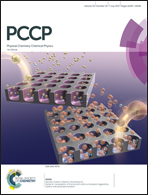A phenomenological order approach to the volume phase transition in microgel particles
Abstract
We proposed a model to describe the volume phase transition of microgel particles, based on constitutive relations that consider the mechano-chemical coupling of deformation and solvency processes, as well as the phenomenological cooperative effect of molecular orientation of solvatable segments in the particles. We regard a nematic–isotropic like transition and define a tensor order parameter allowing analysis of the collective behaviour of water solvation mechanisms based on the Landau–De Gennes theory for liquid crystal elastomers. A complementary approach to the energy balance density is obtained with the order parameter field considering the deformation by a continuum mechanics approximation; our approach aims to extend the comprehensive understanding of the elastic behaviour and water sorption related phenomena in microgel particles. With the proposed model, we reproduce the behaviour of swelling curves through a volume phase transition of thermosensitive microgel particles by assessing characteristic parameters belonging to particular physical properties. The parameters defined within the model such as elastic and solvency related constants and characteristic temperatures were obtained by fitting of a data set mimicking the experimentally observed swelling behaviour. The obtained values of the parameters were consistent with the discussed phenomenology which shows the importance of molecular ordering interpretation as a source to describe the volume phase transition in microgel particles.



 Please wait while we load your content...
Please wait while we load your content...